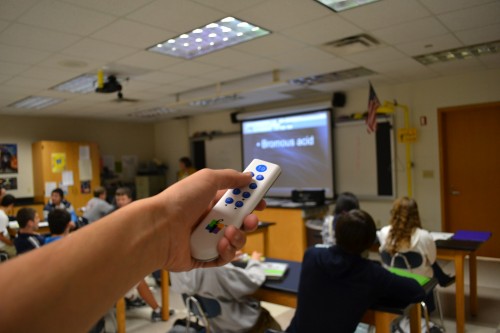With increased talk of new technology in schools, Carmel Clay Schools should consider bringing in more of these advancements into its own classrooms. TI-Nspires, Smartboards and clickers are already being used in some classes, but Carmel Clay Schools, which is supposedly a leader of education in the nation, should incorporate other technologies as well, such as replacing textbooks with e-readers, tablets or laptops. According to a 2011 New York Times article, some schools across the nation have already made the switched a while ago, including schools in Munster, IN. Using electronics rather than textbooks offers several benefits. Although switching from paper to electronics may sound expensive, the fee for buying computers is comparable to the old fees of textbooks. While an iPad 2 costs $500, a new textbook costs about $100 per book. With almost every course requiring a textbook and the fact that books must constantly be updated and replaced, a technological approach seems economical in comparison. Currently, when there are errors found in a textbook or when discoveries have been made, they must be added into upcoming editions while books that schools possess stay flawed and outdated. By going digital, updates with new information and corrections can be instant and simple.
Also, students wouldn’t have to carry backpacks filled with textbooks, making everyday life easier. In fact, carrying heavy backpacks frequently causes back pain and posture problems, which is especially important during adolescence when children are still growing. By storing the information in bytes and files rather than pages and pages, going digital can prove to be lightweight as well as ecofriendly. Learning materials can also be more engaging as students can highlight and mark pages, watch videos and listen to explanations. With interactive lessons, students become interested and learn more as a result. When it comes to electronics, students (and, quite honestly, everyone) tend to get distracted. Most people see a Mac or a PC as a means of surfing the web and escaping from reality, not a means of working or doing business. However, this problem will resolve itself in time once students adjust to the mindset of using technology for schoolwork. In the meantime, schools can easily restrict Internet access to only allow certain websites, and computer functions can easily be programmed and geared toward school. Perhaps if technology became widely used for education, companies like Microsoft and Apple could make school-based electronics.
We acknowledge that when it comes to schools and laptops, the issue of privacy arises. The Lower Merion School District in Pennsylvania made headlines last year for using school-issued laptops’ webcams to spy on students. However, taking the necessary legal precautions can easily prevent any mishaps like these. In addition, prolonged exposure to computer screens have been shown to decreases vision and cause lethargy. Having the technology at hand in the classroom allows teachers to instruct students on how to better use that technology and, therefore, better prevent these potential problems.
Overall, we believe that our school district should embrace this trend of implementing more technology as a way of improving the students’ education. However, our schools shouldn’t rush this development; rather, the switch should be gradual. As with any large-scale change, the transition period in between may be rough. Teachers must be trained to operate new technology, and students may find it difficult to concentrate while studying with electronics. Parents will initially have mixed feelings about all of these changes. But in time, once classrooms adapt to the new method of schooling, students may find that many improvements have been made as a result of the switch. Students will have less to carry every day. Millions of pages won’t need to be printed for textbooks. Rather than purchasing a new set of textbooks, old versions can simply be updated. Students can learn more from interesting videos and interactive lessons. Implementing technology in schools may open up a lot of doors for CHS to bigger and better ideas and may just be the first step toward a more efficient future.
Click here to see the news article on technology in classrooms at CHS.

































![British royalty are American celebrities [opinion]](https://hilite.org/wp-content/uploads/2024/03/Screenshot-2024-03-24-1.44.57-PM.png)



















![Chelsea Meng on her instagram-run bracelet shop [Biz Buzz]](https://hilite.org/wp-content/uploads/2024/04/IMG_2446-1200x838.jpg)
![Review: Quiet on Set: The Dark Side of Kids TV is the long awaited exposé of pedophilia within the children’s entertainment industry [MUSE]](https://hilite.org/wp-content/uploads/2024/04/unnamed.jpg)
![Review: “The Iron Claw” cannot get enough praise [MUSE]](https://hilite.org/wp-content/uploads/2024/04/unnamed.png)
![Review: “The Bear” sets an unbelievably high bar for future comedy shows [MUSE]](https://hilite.org/wp-content/uploads/2024/03/unnamed.png)
![Review: “Mysterious Lotus Casebook” is an amazing historical Chinese drama [MUSE]](https://hilite.org/wp-content/uploads/2024/03/0.webp)
![Review in Print: Maripaz Villar brings a delightfully unique style to the world of WEBTOON [MUSE]](https://hilite.org/wp-content/uploads/2023/12/maripazcover-1200x960.jpg)
![Review: “The Sword of Kaigen” is a masterpiece [MUSE]](https://hilite.org/wp-content/uploads/2023/11/Screenshot-2023-11-26-201051.png)
![Review: Gateron Oil Kings, great linear switches, okay price [MUSE]](https://hilite.org/wp-content/uploads/2023/11/Screenshot-2023-11-26-200553.png)
![Review: “A Haunting in Venice” is a significant improvement from other Agatha Christie adaptations [MUSE]](https://hilite.org/wp-content/uploads/2023/11/e7ee2938a6d422669771bce6d8088521.jpg)
![Review: A Thanksgiving story from elementary school, still just as interesting [MUSE]](https://hilite.org/wp-content/uploads/2023/11/Screenshot-2023-11-26-195514-987x1200.png)
![Review: When I Fly Towards You, cute, uplifting youth drama [MUSE]](https://hilite.org/wp-content/uploads/2023/09/When-I-Fly-Towards-You-Chinese-drama.png)
![Postcards from Muse: Hawaii Travel Diary [MUSE]](https://hilite.org/wp-content/uploads/2023/09/My-project-1-1200x1200.jpg)
![Review: Ladybug & Cat Noir: The Movie, departure from original show [MUSE]](https://hilite.org/wp-content/uploads/2023/09/Ladybug__Cat_Noir_-_The_Movie_poster.jpg)
![Review in Print: Hidden Love is the cute, uplifting drama everyone needs [MUSE]](https://hilite.org/wp-content/uploads/2023/09/hiddenlovecover-e1693597208225-1030x1200.png)
![Review in Print: Heartstopper is the heartwarming queer romance we all need [MUSE]](https://hilite.org/wp-content/uploads/2023/08/museheartstoppercover-1200x654.png)






















![Review: Ladybug & Cat Noir: The Movie, departure from original show [MUSE]](https://hilite.org/wp-content/uploads/2023/09/Ladybug__Cat_Noir_-_The_Movie_poster-221x300.jpg)

![Review: Next in Fashion season two survives changes, becomes a valuable pop culture artifact [MUSE]](https://hilite.org/wp-content/uploads/2023/03/Screen-Shot-2023-03-09-at-11.05.05-AM-300x214.png)
![Review: Is The Stormlight Archive worth it? [MUSE]](https://hilite.org/wp-content/uploads/2023/10/unnamed-1-184x300.png)



devin • Jun 29, 2012 at 10:45 am
technology is everywhere now and it can do almost anything
arvell • Jun 29, 2012 at 10:40 am
I use my iPad to do all my homework and to do projects. You can download Apple’s version of Word, PowerPoint, and Excel. I don’t take home my textbooks because I can access the online books directly from my iPad resulting in a lighter backpack. I don’t feel like I get distracted by doing my schoolwork on the iPad. Carmel definatley needs to adopt the iPad if they want to continue to be a leader in education.
Nick • Dec 29, 2011 at 2:47 pm
I use my iPad to do all my homework and to do projects. You can download Apple’s version of Word, PowerPoint, and Excel. I don’t take home my textbooks because I can access the online books directly from my iPad resulting in a lighter backpack. I don’t feel like I get distracted by doing my schoolwork on the iPad. Carmel definatley needs to adopt the iPad if they want to continue to be a leader in education.